Civil Engineering Report: Green Building Design and Sustainability
VerifiedAdded on 2022/08/25
|12
|3012
|14
Report
AI Summary
This report delves into the critical role of civil engineers in designing sustainable buildings to minimize environmental impact. It examines the increasing importance of green building design, driven by international conventions and the need to reduce the carbon footprint of the building sector. The report emphasizes the significance of utilizing natural processes, such as natural lighting and ventilation, to reduce electricity consumption and greenhouse gas emissions. It discusses the IPCC report on climate change and the importance of integrating climate change measures into policy implementation. Current practices in building design are evaluated, highlighting the overuse of heating, ventilation, and cooling systems. The report explores sustainable design elements, including the use of hollow core slabs for thermal energy storage and natural ventilation systems to reduce energy requirements. Water management is also discussed, emphasizing the importance of water conservation in green building design. The report concludes by underscoring the need for comprehensive strategies to achieve sustainable building practices and reduce environmental impact.
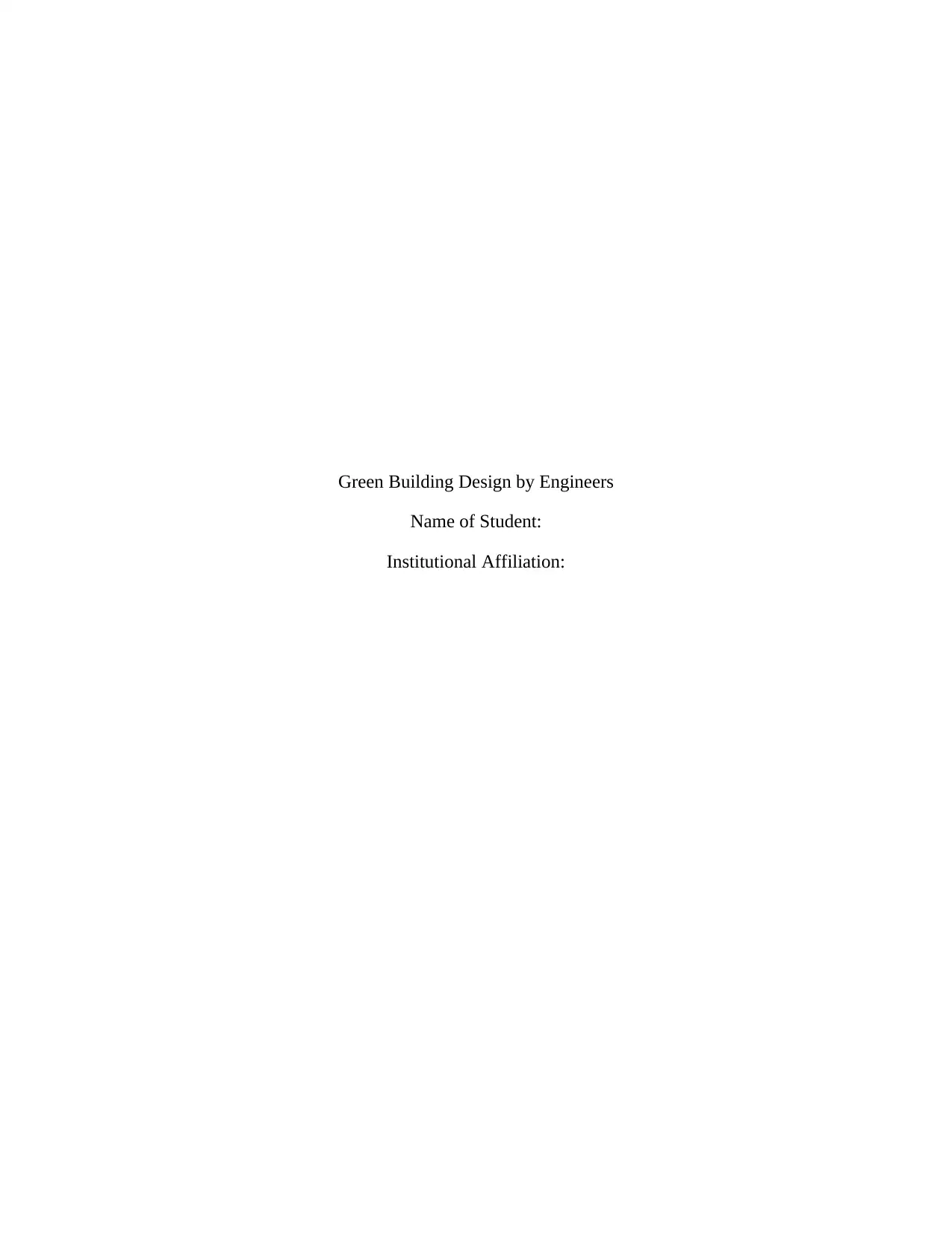
Green Building Design by Engineers
Name of Student:
Institutional Affiliation:
Name of Student:
Institutional Affiliation:
Paraphrase This Document
Need a fresh take? Get an instant paraphrase of this document with our AI Paraphraser
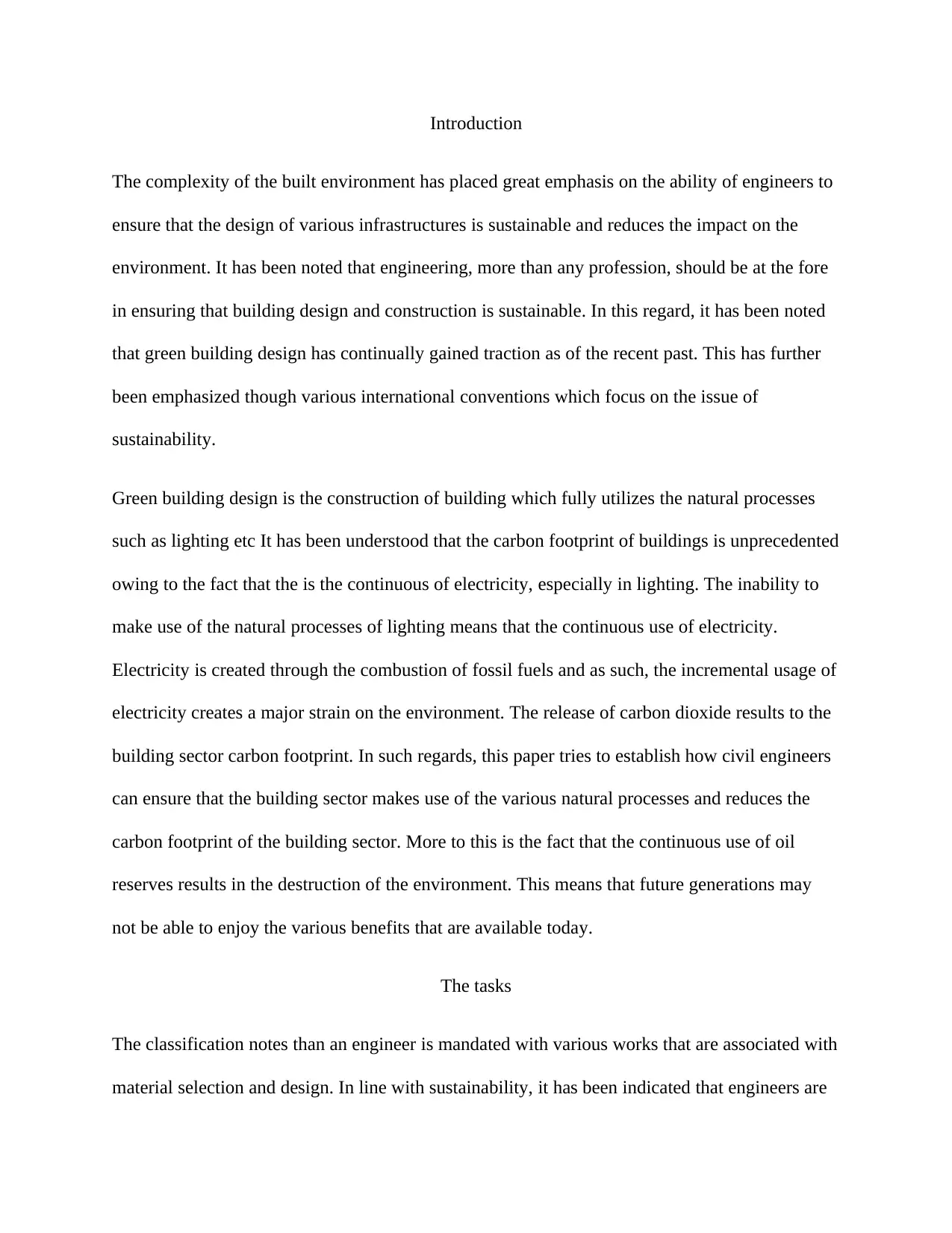
Introduction
The complexity of the built environment has placed great emphasis on the ability of engineers to
ensure that the design of various infrastructures is sustainable and reduces the impact on the
environment. It has been noted that engineering, more than any profession, should be at the fore
in ensuring that building design and construction is sustainable. In this regard, it has been noted
that green building design has continually gained traction as of the recent past. This has further
been emphasized though various international conventions which focus on the issue of
sustainability.
Green building design is the construction of building which fully utilizes the natural processes
such as lighting etc It has been understood that the carbon footprint of buildings is unprecedented
owing to the fact that the is the continuous of electricity, especially in lighting. The inability to
make use of the natural processes of lighting means that the continuous use of electricity.
Electricity is created through the combustion of fossil fuels and as such, the incremental usage of
electricity creates a major strain on the environment. The release of carbon dioxide results to the
building sector carbon footprint. In such regards, this paper tries to establish how civil engineers
can ensure that the building sector makes use of the various natural processes and reduces the
carbon footprint of the building sector. More to this is the fact that the continuous use of oil
reserves results in the destruction of the environment. This means that future generations may
not be able to enjoy the various benefits that are available today.
The tasks
The classification notes than an engineer is mandated with various works that are associated with
material selection and design. In line with sustainability, it has been indicated that engineers are
The complexity of the built environment has placed great emphasis on the ability of engineers to
ensure that the design of various infrastructures is sustainable and reduces the impact on the
environment. It has been noted that engineering, more than any profession, should be at the fore
in ensuring that building design and construction is sustainable. In this regard, it has been noted
that green building design has continually gained traction as of the recent past. This has further
been emphasized though various international conventions which focus on the issue of
sustainability.
Green building design is the construction of building which fully utilizes the natural processes
such as lighting etc It has been understood that the carbon footprint of buildings is unprecedented
owing to the fact that the is the continuous of electricity, especially in lighting. The inability to
make use of the natural processes of lighting means that the continuous use of electricity.
Electricity is created through the combustion of fossil fuels and as such, the incremental usage of
electricity creates a major strain on the environment. The release of carbon dioxide results to the
building sector carbon footprint. In such regards, this paper tries to establish how civil engineers
can ensure that the building sector makes use of the various natural processes and reduces the
carbon footprint of the building sector. More to this is the fact that the continuous use of oil
reserves results in the destruction of the environment. This means that future generations may
not be able to enjoy the various benefits that are available today.
The tasks
The classification notes than an engineer is mandated with various works that are associated with
material selection and design. In line with sustainability, it has been indicated that engineers are
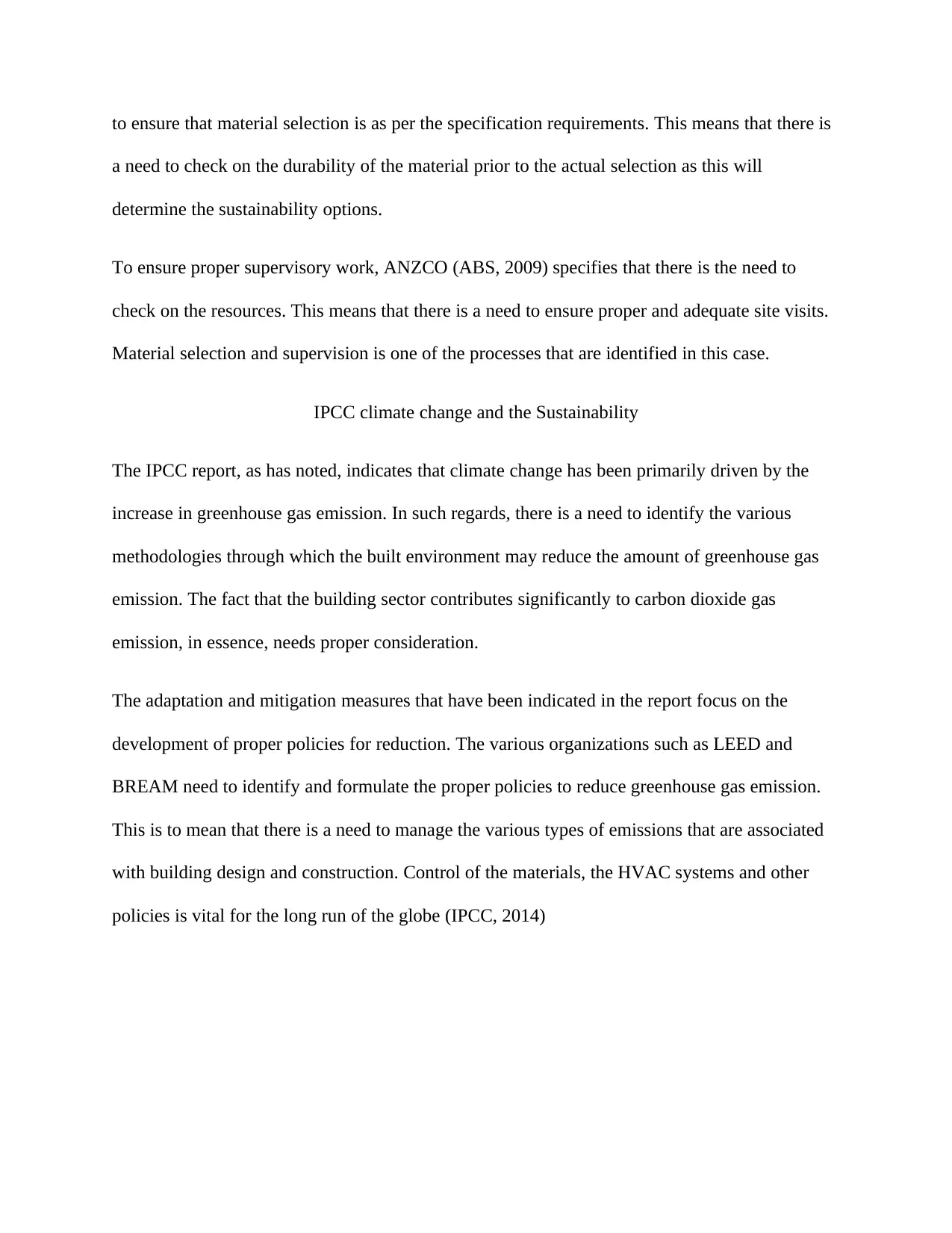
to ensure that material selection is as per the specification requirements. This means that there is
a need to check on the durability of the material prior to the actual selection as this will
determine the sustainability options.
To ensure proper supervisory work, ANZCO (ABS, 2009) specifies that there is the need to
check on the resources. This means that there is a need to ensure proper and adequate site visits.
Material selection and supervision is one of the processes that are identified in this case.
IPCC climate change and the Sustainability
The IPCC report, as has noted, indicates that climate change has been primarily driven by the
increase in greenhouse gas emission. In such regards, there is a need to identify the various
methodologies through which the built environment may reduce the amount of greenhouse gas
emission. The fact that the building sector contributes significantly to carbon dioxide gas
emission, in essence, needs proper consideration.
The adaptation and mitigation measures that have been indicated in the report focus on the
development of proper policies for reduction. The various organizations such as LEED and
BREAM need to identify and formulate the proper policies to reduce greenhouse gas emission.
This is to mean that there is a need to manage the various types of emissions that are associated
with building design and construction. Control of the materials, the HVAC systems and other
policies is vital for the long run of the globe (IPCC, 2014)
a need to check on the durability of the material prior to the actual selection as this will
determine the sustainability options.
To ensure proper supervisory work, ANZCO (ABS, 2009) specifies that there is the need to
check on the resources. This means that there is a need to ensure proper and adequate site visits.
Material selection and supervision is one of the processes that are identified in this case.
IPCC climate change and the Sustainability
The IPCC report, as has noted, indicates that climate change has been primarily driven by the
increase in greenhouse gas emission. In such regards, there is a need to identify the various
methodologies through which the built environment may reduce the amount of greenhouse gas
emission. The fact that the building sector contributes significantly to carbon dioxide gas
emission, in essence, needs proper consideration.
The adaptation and mitigation measures that have been indicated in the report focus on the
development of proper policies for reduction. The various organizations such as LEED and
BREAM need to identify and formulate the proper policies to reduce greenhouse gas emission.
This is to mean that there is a need to manage the various types of emissions that are associated
with building design and construction. Control of the materials, the HVAC systems and other
policies is vital for the long run of the globe (IPCC, 2014)
⊘ This is a preview!⊘
Do you want full access?
Subscribe today to unlock all pages.

Trusted by 1+ million students worldwide
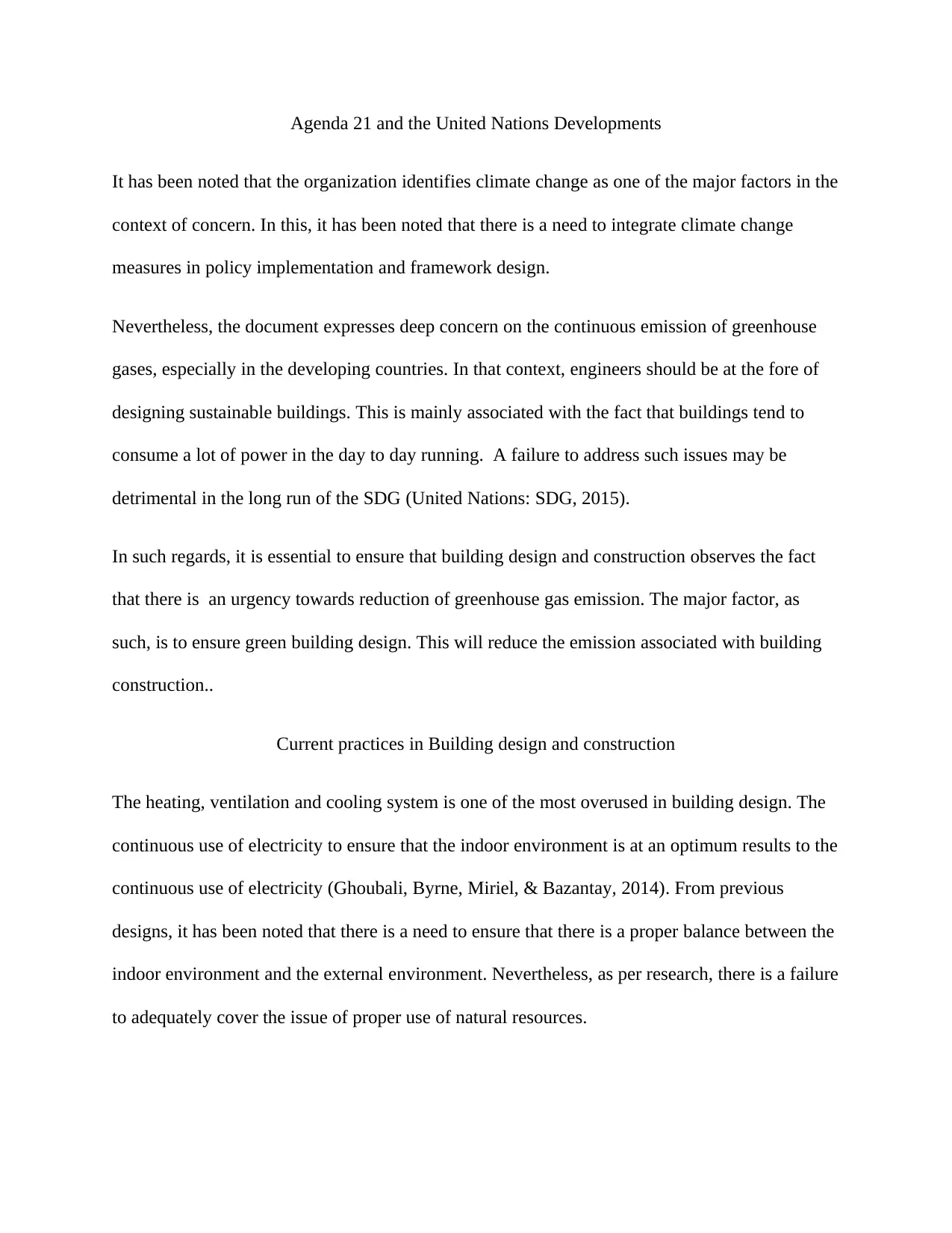
Agenda 21 and the United Nations Developments
It has been noted that the organization identifies climate change as one of the major factors in the
context of concern. In this, it has been noted that there is a need to integrate climate change
measures in policy implementation and framework design.
Nevertheless, the document expresses deep concern on the continuous emission of greenhouse
gases, especially in the developing countries. In that context, engineers should be at the fore of
designing sustainable buildings. This is mainly associated with the fact that buildings tend to
consume a lot of power in the day to day running. A failure to address such issues may be
detrimental in the long run of the SDG (United Nations: SDG, 2015).
In such regards, it is essential to ensure that building design and construction observes the fact
that there is an urgency towards reduction of greenhouse gas emission. The major factor, as
such, is to ensure green building design. This will reduce the emission associated with building
construction..
Current practices in Building design and construction
The heating, ventilation and cooling system is one of the most overused in building design. The
continuous use of electricity to ensure that the indoor environment is at an optimum results to the
continuous use of electricity (Ghoubali, Byrne, Miriel, & Bazantay, 2014). From previous
designs, it has been noted that there is a need to ensure that there is a proper balance between the
indoor environment and the external environment. Nevertheless, as per research, there is a failure
to adequately cover the issue of proper use of natural resources.
It has been noted that the organization identifies climate change as one of the major factors in the
context of concern. In this, it has been noted that there is a need to integrate climate change
measures in policy implementation and framework design.
Nevertheless, the document expresses deep concern on the continuous emission of greenhouse
gases, especially in the developing countries. In that context, engineers should be at the fore of
designing sustainable buildings. This is mainly associated with the fact that buildings tend to
consume a lot of power in the day to day running. A failure to address such issues may be
detrimental in the long run of the SDG (United Nations: SDG, 2015).
In such regards, it is essential to ensure that building design and construction observes the fact
that there is an urgency towards reduction of greenhouse gas emission. The major factor, as
such, is to ensure green building design. This will reduce the emission associated with building
construction..
Current practices in Building design and construction
The heating, ventilation and cooling system is one of the most overused in building design. The
continuous use of electricity to ensure that the indoor environment is at an optimum results to the
continuous use of electricity (Ghoubali, Byrne, Miriel, & Bazantay, 2014). From previous
designs, it has been noted that there is a need to ensure that there is a proper balance between the
indoor environment and the external environment. Nevertheless, as per research, there is a failure
to adequately cover the issue of proper use of natural resources.
Paraphrase This Document
Need a fresh take? Get an instant paraphrase of this document with our AI Paraphraser
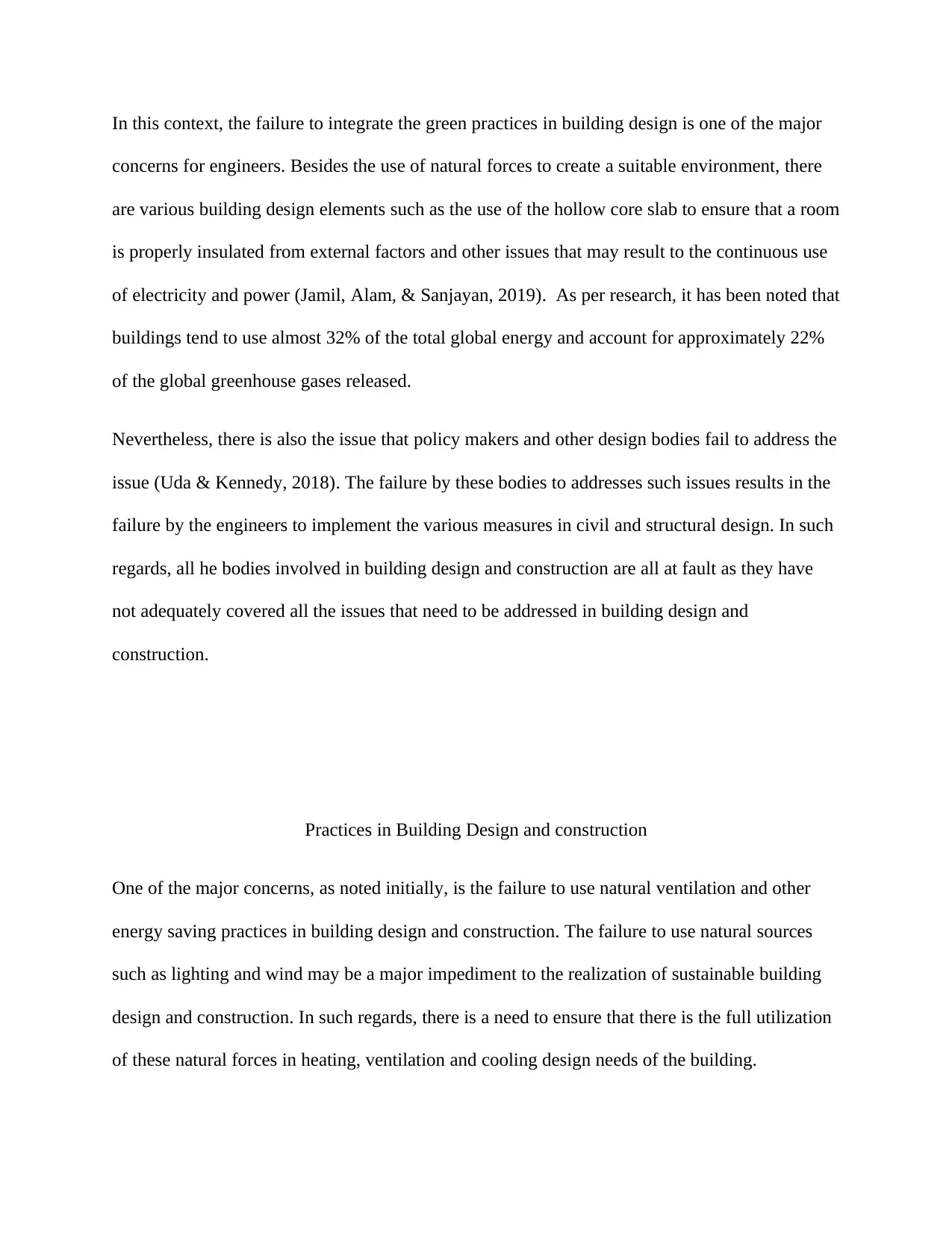
In this context, the failure to integrate the green practices in building design is one of the major
concerns for engineers. Besides the use of natural forces to create a suitable environment, there
are various building design elements such as the use of the hollow core slab to ensure that a room
is properly insulated from external factors and other issues that may result to the continuous use
of electricity and power (Jamil, Alam, & Sanjayan, 2019). As per research, it has been noted that
buildings tend to use almost 32% of the total global energy and account for approximately 22%
of the global greenhouse gases released.
Nevertheless, there is also the issue that policy makers and other design bodies fail to address the
issue (Uda & Kennedy, 2018). The failure by these bodies to addresses such issues results in the
failure by the engineers to implement the various measures in civil and structural design. In such
regards, all he bodies involved in building design and construction are all at fault as they have
not adequately covered all the issues that need to be addressed in building design and
construction.
Practices in Building Design and construction
One of the major concerns, as noted initially, is the failure to use natural ventilation and other
energy saving practices in building design and construction. The failure to use natural sources
such as lighting and wind may be a major impediment to the realization of sustainable building
design and construction. In such regards, there is a need to ensure that there is the full utilization
of these natural forces in heating, ventilation and cooling design needs of the building.
concerns for engineers. Besides the use of natural forces to create a suitable environment, there
are various building design elements such as the use of the hollow core slab to ensure that a room
is properly insulated from external factors and other issues that may result to the continuous use
of electricity and power (Jamil, Alam, & Sanjayan, 2019). As per research, it has been noted that
buildings tend to use almost 32% of the total global energy and account for approximately 22%
of the global greenhouse gases released.
Nevertheless, there is also the issue that policy makers and other design bodies fail to address the
issue (Uda & Kennedy, 2018). The failure by these bodies to addresses such issues results in the
failure by the engineers to implement the various measures in civil and structural design. In such
regards, all he bodies involved in building design and construction are all at fault as they have
not adequately covered all the issues that need to be addressed in building design and
construction.
Practices in Building Design and construction
One of the major concerns, as noted initially, is the failure to use natural ventilation and other
energy saving practices in building design and construction. The failure to use natural sources
such as lighting and wind may be a major impediment to the realization of sustainable building
design and construction. In such regards, there is a need to ensure that there is the full utilization
of these natural forces in heating, ventilation and cooling design needs of the building.
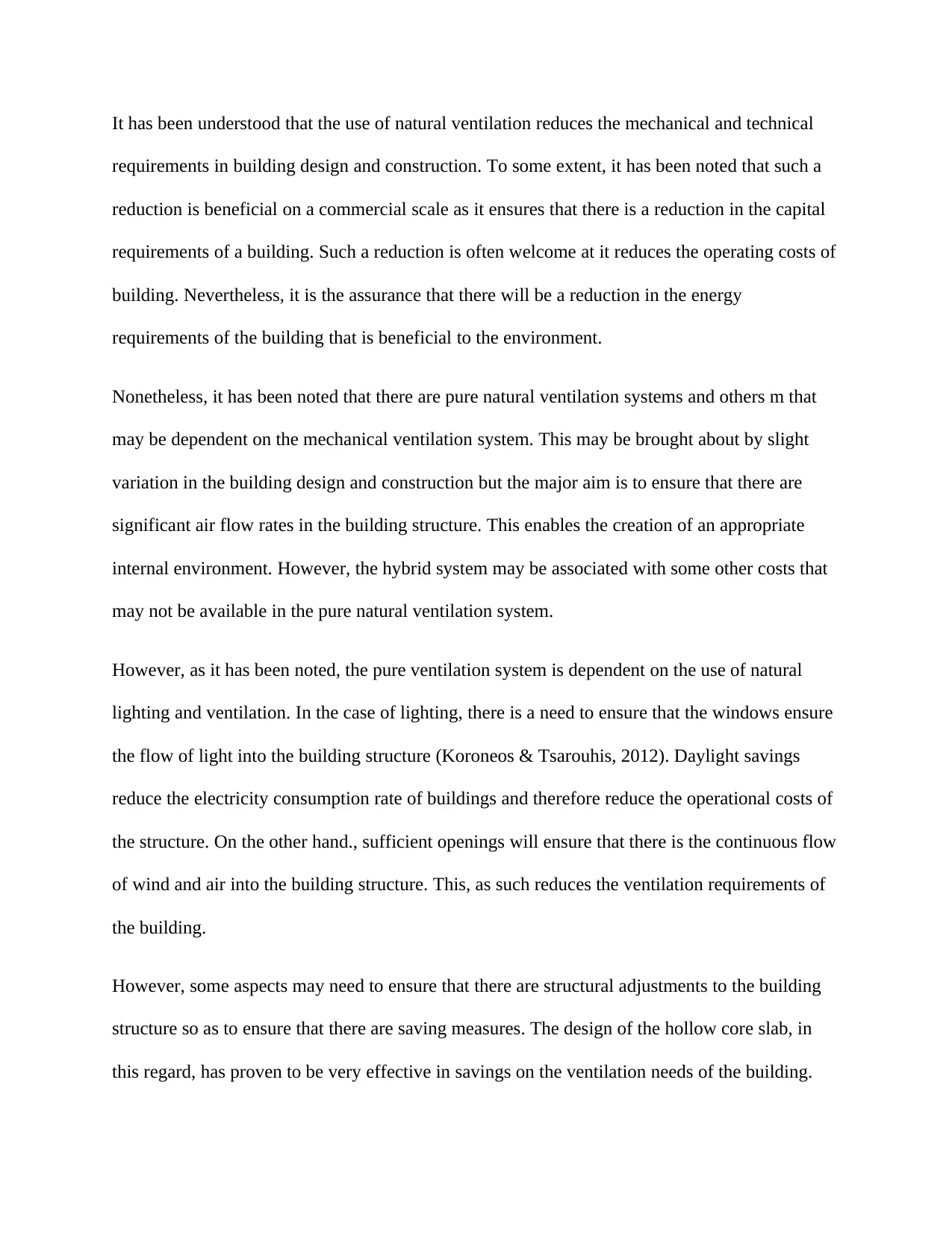
It has been understood that the use of natural ventilation reduces the mechanical and technical
requirements in building design and construction. To some extent, it has been noted that such a
reduction is beneficial on a commercial scale as it ensures that there is a reduction in the capital
requirements of a building. Such a reduction is often welcome at it reduces the operating costs of
building. Nevertheless, it is the assurance that there will be a reduction in the energy
requirements of the building that is beneficial to the environment.
Nonetheless, it has been noted that there are pure natural ventilation systems and others m that
may be dependent on the mechanical ventilation system. This may be brought about by slight
variation in the building design and construction but the major aim is to ensure that there are
significant air flow rates in the building structure. This enables the creation of an appropriate
internal environment. However, the hybrid system may be associated with some other costs that
may not be available in the pure natural ventilation system.
However, as it has been noted, the pure ventilation system is dependent on the use of natural
lighting and ventilation. In the case of lighting, there is a need to ensure that the windows ensure
the flow of light into the building structure (Koroneos & Tsarouhis, 2012). Daylight savings
reduce the electricity consumption rate of buildings and therefore reduce the operational costs of
the structure. On the other hand., sufficient openings will ensure that there is the continuous flow
of wind and air into the building structure. This, as such reduces the ventilation requirements of
the building.
However, some aspects may need to ensure that there are structural adjustments to the building
structure so as to ensure that there are saving measures. The design of the hollow core slab, in
this regard, has proven to be very effective in savings on the ventilation needs of the building.
requirements in building design and construction. To some extent, it has been noted that such a
reduction is beneficial on a commercial scale as it ensures that there is a reduction in the capital
requirements of a building. Such a reduction is often welcome at it reduces the operating costs of
building. Nevertheless, it is the assurance that there will be a reduction in the energy
requirements of the building that is beneficial to the environment.
Nonetheless, it has been noted that there are pure natural ventilation systems and others m that
may be dependent on the mechanical ventilation system. This may be brought about by slight
variation in the building design and construction but the major aim is to ensure that there are
significant air flow rates in the building structure. This enables the creation of an appropriate
internal environment. However, the hybrid system may be associated with some other costs that
may not be available in the pure natural ventilation system.
However, as it has been noted, the pure ventilation system is dependent on the use of natural
lighting and ventilation. In the case of lighting, there is a need to ensure that the windows ensure
the flow of light into the building structure (Koroneos & Tsarouhis, 2012). Daylight savings
reduce the electricity consumption rate of buildings and therefore reduce the operational costs of
the structure. On the other hand., sufficient openings will ensure that there is the continuous flow
of wind and air into the building structure. This, as such reduces the ventilation requirements of
the building.
However, some aspects may need to ensure that there are structural adjustments to the building
structure so as to ensure that there are saving measures. The design of the hollow core slab, in
this regard, has proven to be very effective in savings on the ventilation needs of the building.
⊘ This is a preview!⊘
Do you want full access?
Subscribe today to unlock all pages.

Trusted by 1+ million students worldwide
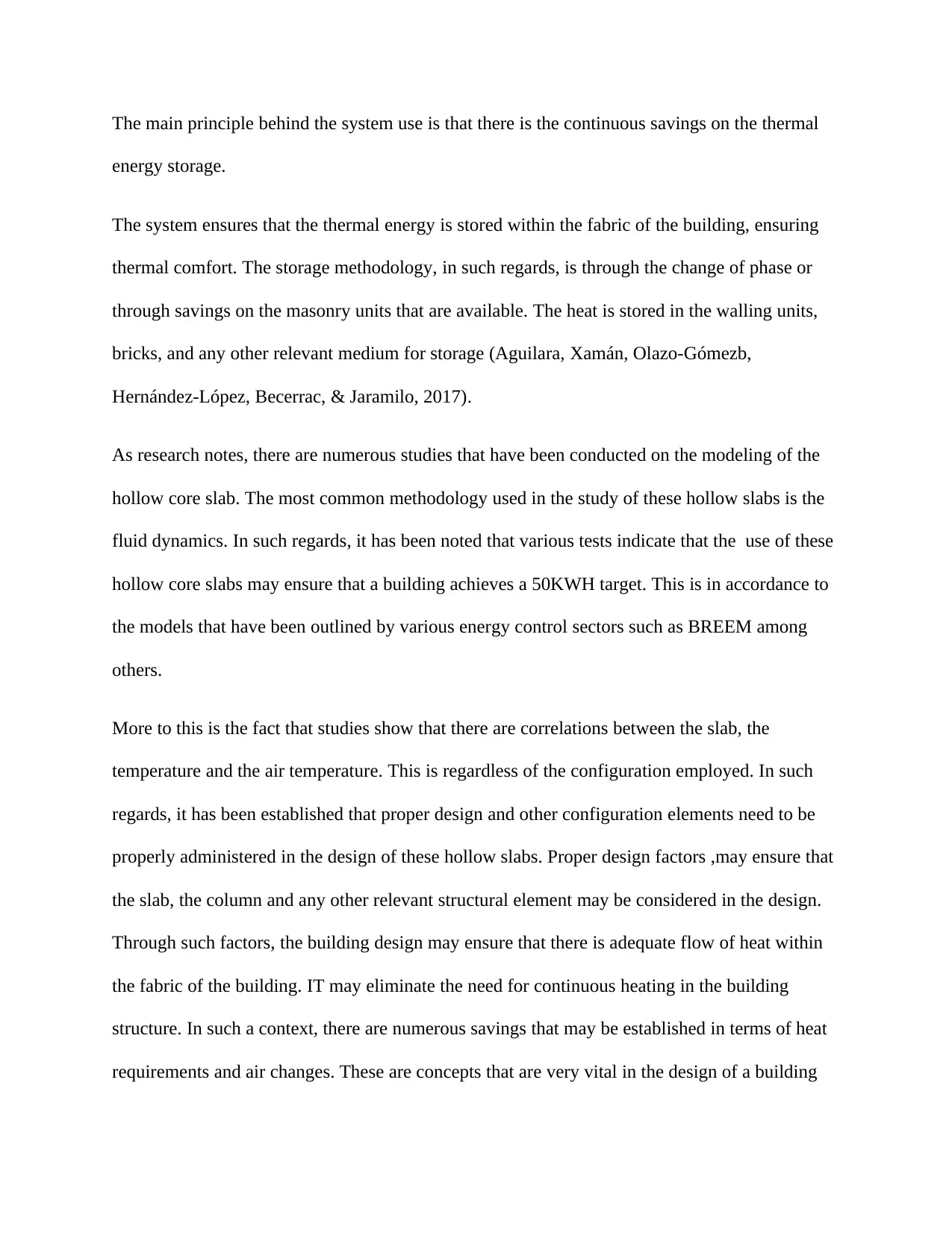
The main principle behind the system use is that there is the continuous savings on the thermal
energy storage.
The system ensures that the thermal energy is stored within the fabric of the building, ensuring
thermal comfort. The storage methodology, in such regards, is through the change of phase or
through savings on the masonry units that are available. The heat is stored in the walling units,
bricks, and any other relevant medium for storage (Aguilara, Xamán, Olazo-Gómezb,
Hernández-López, Becerrac, & Jaramilo, 2017).
As research notes, there are numerous studies that have been conducted on the modeling of the
hollow core slab. The most common methodology used in the study of these hollow slabs is the
fluid dynamics. In such regards, it has been noted that various tests indicate that the use of these
hollow core slabs may ensure that a building achieves a 50KWH target. This is in accordance to
the models that have been outlined by various energy control sectors such as BREEM among
others.
More to this is the fact that studies show that there are correlations between the slab, the
temperature and the air temperature. This is regardless of the configuration employed. In such
regards, it has been established that proper design and other configuration elements need to be
properly administered in the design of these hollow slabs. Proper design factors ,may ensure that
the slab, the column and any other relevant structural element may be considered in the design.
Through such factors, the building design may ensure that there is adequate flow of heat within
the fabric of the building. IT may eliminate the need for continuous heating in the building
structure. In such a context, there are numerous savings that may be established in terms of heat
requirements and air changes. These are concepts that are very vital in the design of a building
energy storage.
The system ensures that the thermal energy is stored within the fabric of the building, ensuring
thermal comfort. The storage methodology, in such regards, is through the change of phase or
through savings on the masonry units that are available. The heat is stored in the walling units,
bricks, and any other relevant medium for storage (Aguilara, Xamán, Olazo-Gómezb,
Hernández-López, Becerrac, & Jaramilo, 2017).
As research notes, there are numerous studies that have been conducted on the modeling of the
hollow core slab. The most common methodology used in the study of these hollow slabs is the
fluid dynamics. In such regards, it has been noted that various tests indicate that the use of these
hollow core slabs may ensure that a building achieves a 50KWH target. This is in accordance to
the models that have been outlined by various energy control sectors such as BREEM among
others.
More to this is the fact that studies show that there are correlations between the slab, the
temperature and the air temperature. This is regardless of the configuration employed. In such
regards, it has been established that proper design and other configuration elements need to be
properly administered in the design of these hollow slabs. Proper design factors ,may ensure that
the slab, the column and any other relevant structural element may be considered in the design.
Through such factors, the building design may ensure that there is adequate flow of heat within
the fabric of the building. IT may eliminate the need for continuous heating in the building
structure. In such a context, there are numerous savings that may be established in terms of heat
requirements and air changes. These are concepts that are very vital in the design of a building
Paraphrase This Document
Need a fresh take? Get an instant paraphrase of this document with our AI Paraphraser
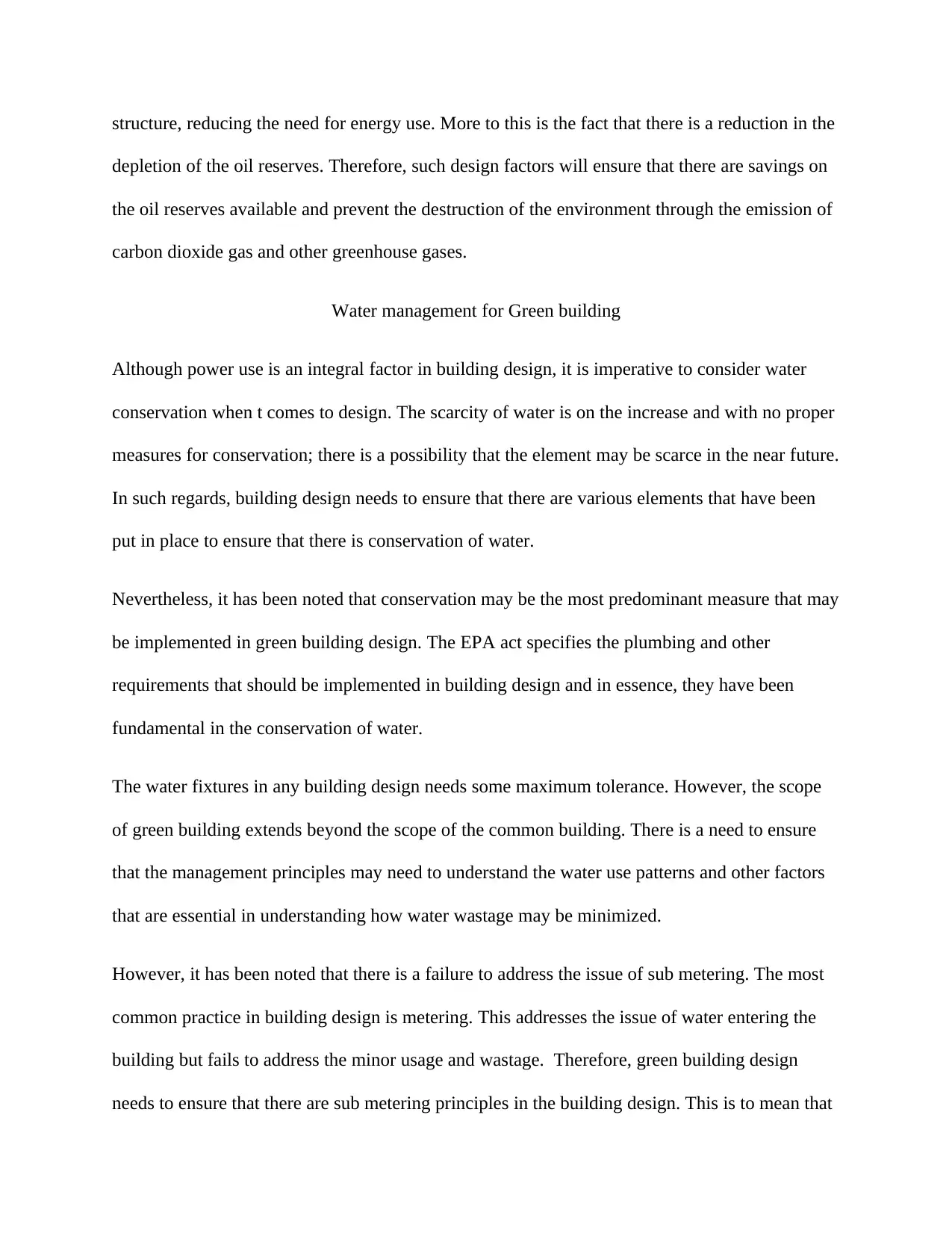
structure, reducing the need for energy use. More to this is the fact that there is a reduction in the
depletion of the oil reserves. Therefore, such design factors will ensure that there are savings on
the oil reserves available and prevent the destruction of the environment through the emission of
carbon dioxide gas and other greenhouse gases.
Water management for Green building
Although power use is an integral factor in building design, it is imperative to consider water
conservation when t comes to design. The scarcity of water is on the increase and with no proper
measures for conservation; there is a possibility that the element may be scarce in the near future.
In such regards, building design needs to ensure that there are various elements that have been
put in place to ensure that there is conservation of water.
Nevertheless, it has been noted that conservation may be the most predominant measure that may
be implemented in green building design. The EPA act specifies the plumbing and other
requirements that should be implemented in building design and in essence, they have been
fundamental in the conservation of water.
The water fixtures in any building design needs some maximum tolerance. However, the scope
of green building extends beyond the scope of the common building. There is a need to ensure
that the management principles may need to understand the water use patterns and other factors
that are essential in understanding how water wastage may be minimized.
However, it has been noted that there is a failure to address the issue of sub metering. The most
common practice in building design is metering. This addresses the issue of water entering the
building but fails to address the minor usage and wastage. Therefore, green building design
needs to ensure that there are sub metering principles in the building design. This is to mean that
depletion of the oil reserves. Therefore, such design factors will ensure that there are savings on
the oil reserves available and prevent the destruction of the environment through the emission of
carbon dioxide gas and other greenhouse gases.
Water management for Green building
Although power use is an integral factor in building design, it is imperative to consider water
conservation when t comes to design. The scarcity of water is on the increase and with no proper
measures for conservation; there is a possibility that the element may be scarce in the near future.
In such regards, building design needs to ensure that there are various elements that have been
put in place to ensure that there is conservation of water.
Nevertheless, it has been noted that conservation may be the most predominant measure that may
be implemented in green building design. The EPA act specifies the plumbing and other
requirements that should be implemented in building design and in essence, they have been
fundamental in the conservation of water.
The water fixtures in any building design needs some maximum tolerance. However, the scope
of green building extends beyond the scope of the common building. There is a need to ensure
that the management principles may need to understand the water use patterns and other factors
that are essential in understanding how water wastage may be minimized.
However, it has been noted that there is a failure to address the issue of sub metering. The most
common practice in building design is metering. This addresses the issue of water entering the
building but fails to address the minor usage and wastage. Therefore, green building design
needs to ensure that there are sub metering principles in the building design. This is to mean that
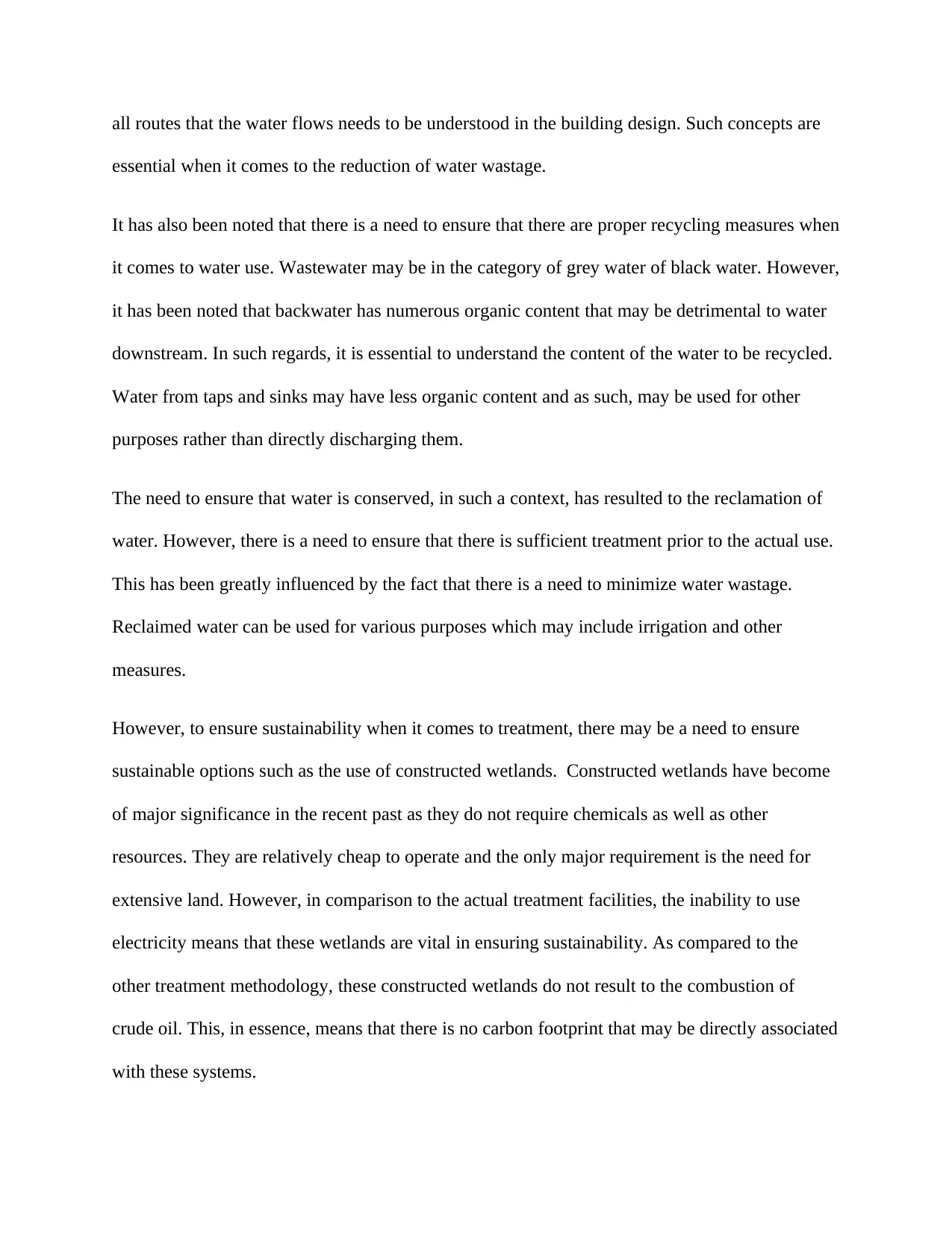
all routes that the water flows needs to be understood in the building design. Such concepts are
essential when it comes to the reduction of water wastage.
It has also been noted that there is a need to ensure that there are proper recycling measures when
it comes to water use. Wastewater may be in the category of grey water of black water. However,
it has been noted that backwater has numerous organic content that may be detrimental to water
downstream. In such regards, it is essential to understand the content of the water to be recycled.
Water from taps and sinks may have less organic content and as such, may be used for other
purposes rather than directly discharging them.
The need to ensure that water is conserved, in such a context, has resulted to the reclamation of
water. However, there is a need to ensure that there is sufficient treatment prior to the actual use.
This has been greatly influenced by the fact that there is a need to minimize water wastage.
Reclaimed water can be used for various purposes which may include irrigation and other
measures.
However, to ensure sustainability when it comes to treatment, there may be a need to ensure
sustainable options such as the use of constructed wetlands. Constructed wetlands have become
of major significance in the recent past as they do not require chemicals as well as other
resources. They are relatively cheap to operate and the only major requirement is the need for
extensive land. However, in comparison to the actual treatment facilities, the inability to use
electricity means that these wetlands are vital in ensuring sustainability. As compared to the
other treatment methodology, these constructed wetlands do not result to the combustion of
crude oil. This, in essence, means that there is no carbon footprint that may be directly associated
with these systems.
essential when it comes to the reduction of water wastage.
It has also been noted that there is a need to ensure that there are proper recycling measures when
it comes to water use. Wastewater may be in the category of grey water of black water. However,
it has been noted that backwater has numerous organic content that may be detrimental to water
downstream. In such regards, it is essential to understand the content of the water to be recycled.
Water from taps and sinks may have less organic content and as such, may be used for other
purposes rather than directly discharging them.
The need to ensure that water is conserved, in such a context, has resulted to the reclamation of
water. However, there is a need to ensure that there is sufficient treatment prior to the actual use.
This has been greatly influenced by the fact that there is a need to minimize water wastage.
Reclaimed water can be used for various purposes which may include irrigation and other
measures.
However, to ensure sustainability when it comes to treatment, there may be a need to ensure
sustainable options such as the use of constructed wetlands. Constructed wetlands have become
of major significance in the recent past as they do not require chemicals as well as other
resources. They are relatively cheap to operate and the only major requirement is the need for
extensive land. However, in comparison to the actual treatment facilities, the inability to use
electricity means that these wetlands are vital in ensuring sustainability. As compared to the
other treatment methodology, these constructed wetlands do not result to the combustion of
crude oil. This, in essence, means that there is no carbon footprint that may be directly associated
with these systems.
⊘ This is a preview!⊘
Do you want full access?
Subscribe today to unlock all pages.

Trusted by 1+ million students worldwide
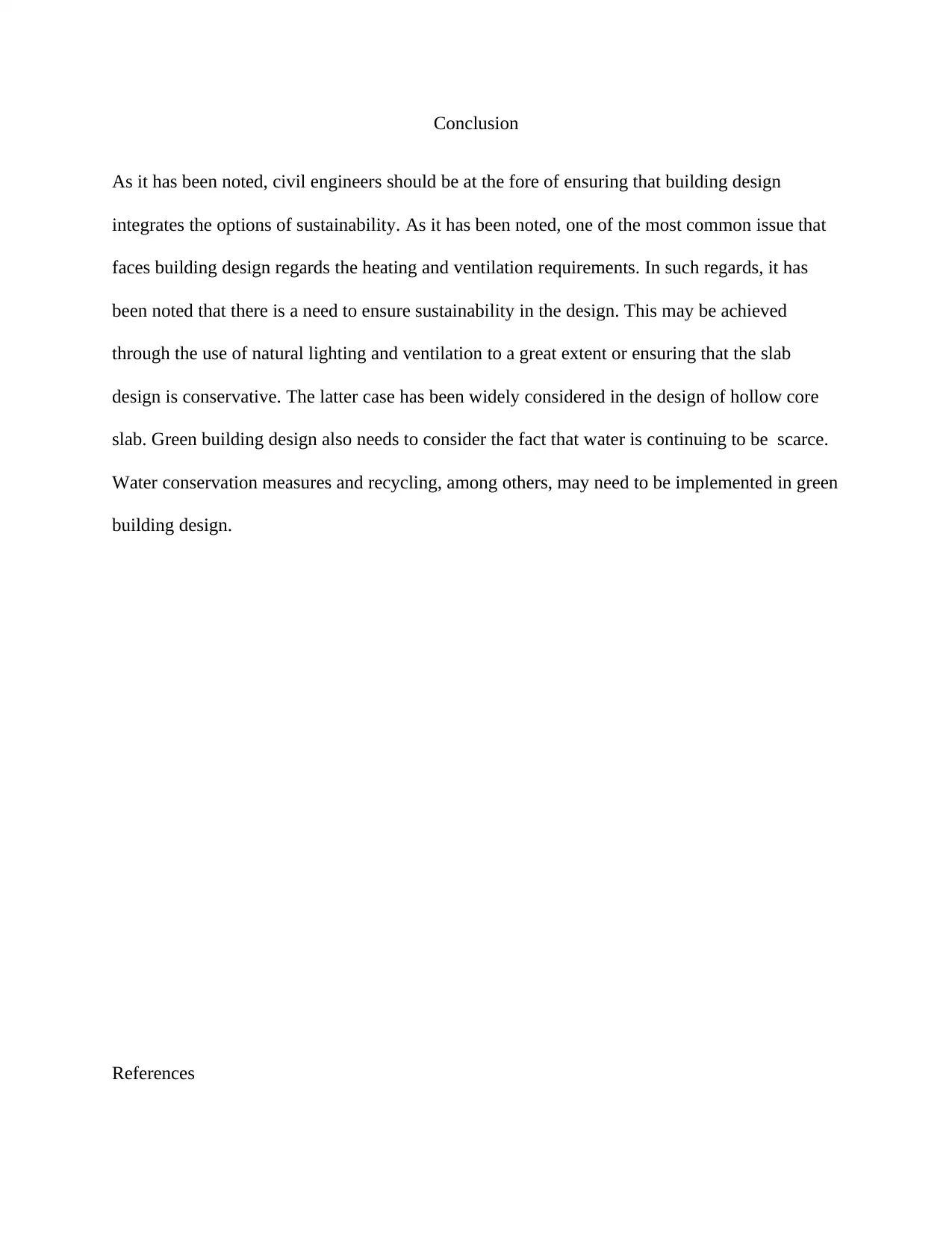
Conclusion
As it has been noted, civil engineers should be at the fore of ensuring that building design
integrates the options of sustainability. As it has been noted, one of the most common issue that
faces building design regards the heating and ventilation requirements. In such regards, it has
been noted that there is a need to ensure sustainability in the design. This may be achieved
through the use of natural lighting and ventilation to a great extent or ensuring that the slab
design is conservative. The latter case has been widely considered in the design of hollow core
slab. Green building design also needs to consider the fact that water is continuing to be scarce.
Water conservation measures and recycling, among others, may need to be implemented in green
building design.
References
As it has been noted, civil engineers should be at the fore of ensuring that building design
integrates the options of sustainability. As it has been noted, one of the most common issue that
faces building design regards the heating and ventilation requirements. In such regards, it has
been noted that there is a need to ensure sustainability in the design. This may be achieved
through the use of natural lighting and ventilation to a great extent or ensuring that the slab
design is conservative. The latter case has been widely considered in the design of hollow core
slab. Green building design also needs to consider the fact that water is continuing to be scarce.
Water conservation measures and recycling, among others, may need to be implemented in green
building design.
References
Paraphrase This Document
Need a fresh take? Get an instant paraphrase of this document with our AI Paraphraser
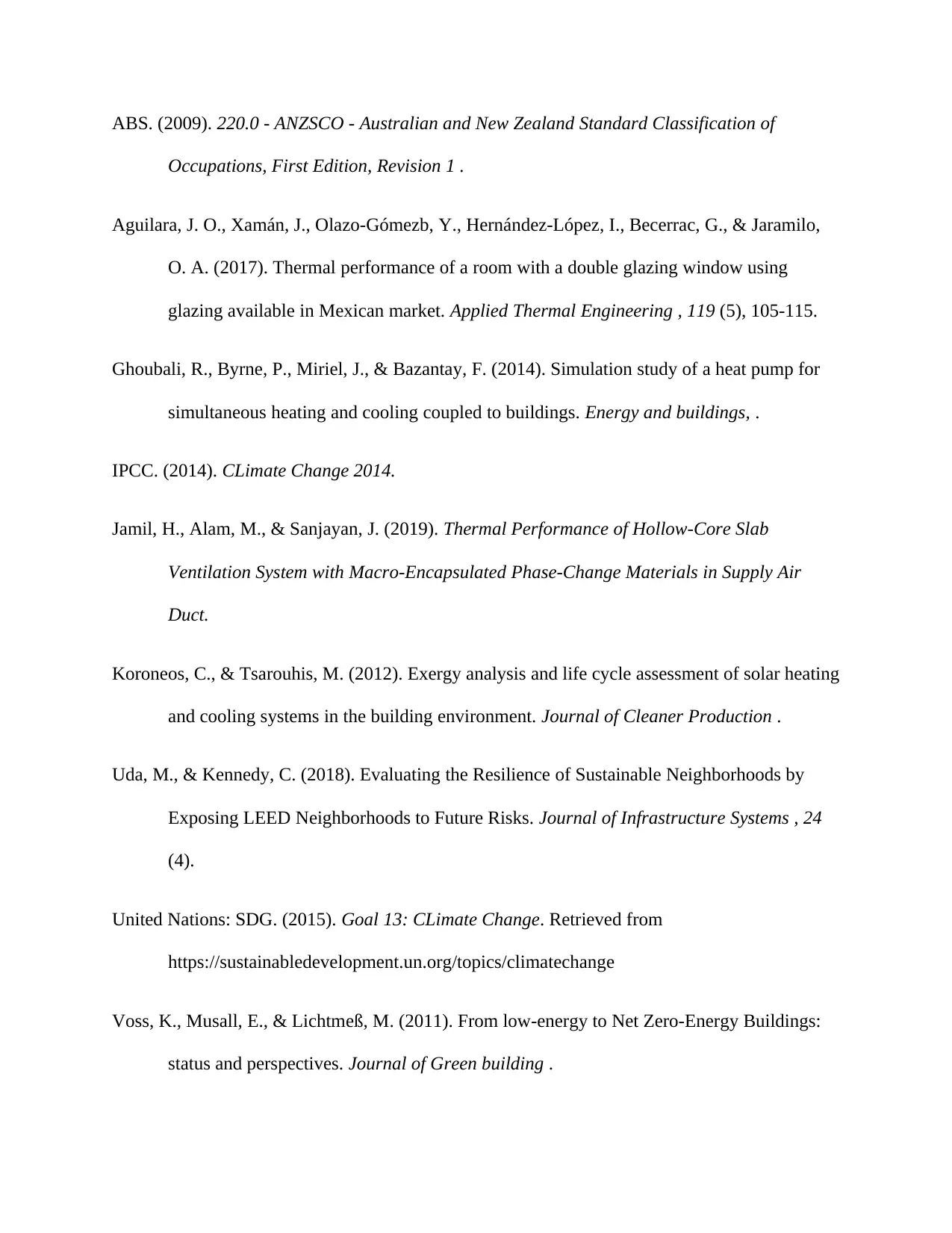
ABS. (2009). 220.0 - ANZSCO - Australian and New Zealand Standard Classification of
Occupations, First Edition, Revision 1 .
Aguilara, J. O., Xamán, J., Olazo-Gómezb, Y., Hernández-López, I., Becerrac, G., & Jaramilo,
O. A. (2017). Thermal performance of a room with a double glazing window using
glazing available in Mexican market. Applied Thermal Engineering , 119 (5), 105-115.
Ghoubali, R., Byrne, P., Miriel, J., & Bazantay, F. (2014). Simulation study of a heat pump for
simultaneous heating and cooling coupled to buildings. Energy and buildings, .
IPCC. (2014). CLimate Change 2014.
Jamil, H., Alam, M., & Sanjayan, J. (2019). Thermal Performance of Hollow-Core Slab
Ventilation System with Macro-Encapsulated Phase-Change Materials in Supply Air
Duct.
Koroneos, C., & Tsarouhis, M. (2012). Exergy analysis and life cycle assessment of solar heating
and cooling systems in the building environment. Journal of Cleaner Production .
Uda, M., & Kennedy, C. (2018). Evaluating the Resilience of Sustainable Neighborhoods by
Exposing LEED Neighborhoods to Future Risks. Journal of Infrastructure Systems , 24
(4).
United Nations: SDG. (2015). Goal 13: CLimate Change. Retrieved from
https://sustainabledevelopment.un.org/topics/climatechange
Voss, K., Musall, E., & Lichtmeß, M. (2011). From low-energy to Net Zero-Energy Buildings:
status and perspectives. Journal of Green building .
Occupations, First Edition, Revision 1 .
Aguilara, J. O., Xamán, J., Olazo-Gómezb, Y., Hernández-López, I., Becerrac, G., & Jaramilo,
O. A. (2017). Thermal performance of a room with a double glazing window using
glazing available in Mexican market. Applied Thermal Engineering , 119 (5), 105-115.
Ghoubali, R., Byrne, P., Miriel, J., & Bazantay, F. (2014). Simulation study of a heat pump for
simultaneous heating and cooling coupled to buildings. Energy and buildings, .
IPCC. (2014). CLimate Change 2014.
Jamil, H., Alam, M., & Sanjayan, J. (2019). Thermal Performance of Hollow-Core Slab
Ventilation System with Macro-Encapsulated Phase-Change Materials in Supply Air
Duct.
Koroneos, C., & Tsarouhis, M. (2012). Exergy analysis and life cycle assessment of solar heating
and cooling systems in the building environment. Journal of Cleaner Production .
Uda, M., & Kennedy, C. (2018). Evaluating the Resilience of Sustainable Neighborhoods by
Exposing LEED Neighborhoods to Future Risks. Journal of Infrastructure Systems , 24
(4).
United Nations: SDG. (2015). Goal 13: CLimate Change. Retrieved from
https://sustainabledevelopment.un.org/topics/climatechange
Voss, K., Musall, E., & Lichtmeß, M. (2011). From low-energy to Net Zero-Energy Buildings:
status and perspectives. Journal of Green building .

⊘ This is a preview!⊘
Do you want full access?
Subscribe today to unlock all pages.

Trusted by 1+ million students worldwide
1 out of 12
Related Documents
Your All-in-One AI-Powered Toolkit for Academic Success.
+13062052269
info@desklib.com
Available 24*7 on WhatsApp / Email
![[object Object]](/_next/static/media/star-bottom.7253800d.svg)
Unlock your academic potential
Copyright © 2020–2025 A2Z Services. All Rights Reserved. Developed and managed by ZUCOL.





